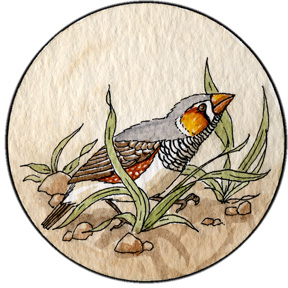


They live throughout the mainland of Australia.
They are found on most types of dry grassland and agricultural lands.
They are medium-sized finches, with bright plumage (feather patterns). Their head and back are grey-brown and with light brown ear patches. Their throat, neck and upper breast are pale grey with fine black stripes (bars). Their lower breast has a broad black bar. Their sides are dark brown with white spots. Their tail cover feathers are striped (barred) black and white. Their legs are orange and their eyes and bill are red. Females look like males but don’t have the black stripes (barring) on their breast. Their throat, breast, belly and bill are pale.
Zebra finches search mostly on the ground for food. They mate for life and live in large flocks.
They eat seeds and insects.
They breed whenever there is rain. They build a dome-shaped, grass nest on a low branch or bush. Females lay 4 -7 white eggs. Both care for the eggs and young.
Kingdom: Animalia
Phylum: Chordata
Subphylum: Vertebrata
Class: Aves
Order: Passeriformes
Family: Estrildidae
Genus: Taeniopygia
Species: T. guttata
When you research information you must cite the reference. Citing for websites is different from citing from books, magazines and periodicals. The style of citing shown here is from the MLA Style Citations (Modern Language Association).
When citing a WEBSITE the general format is as follows.
Author Last Name, First Name(s). "Title: Subtitle of Part of Web Page, if appropriate." Title: Subtitle: Section of Page if appropriate. Sponsoring/Publishing Agency, If Given. Additional significant descriptive information. Date of Electronic Publication or other Date, such as Last Updated. Day Month Year of access < URL >.
Amsel, Sheri. "Finch (Zebra)" Exploring Nature Educational Resource ©2005-2024. December 13, 2024
< http://exploringnature.org/db/view/Finch-Zebra >
